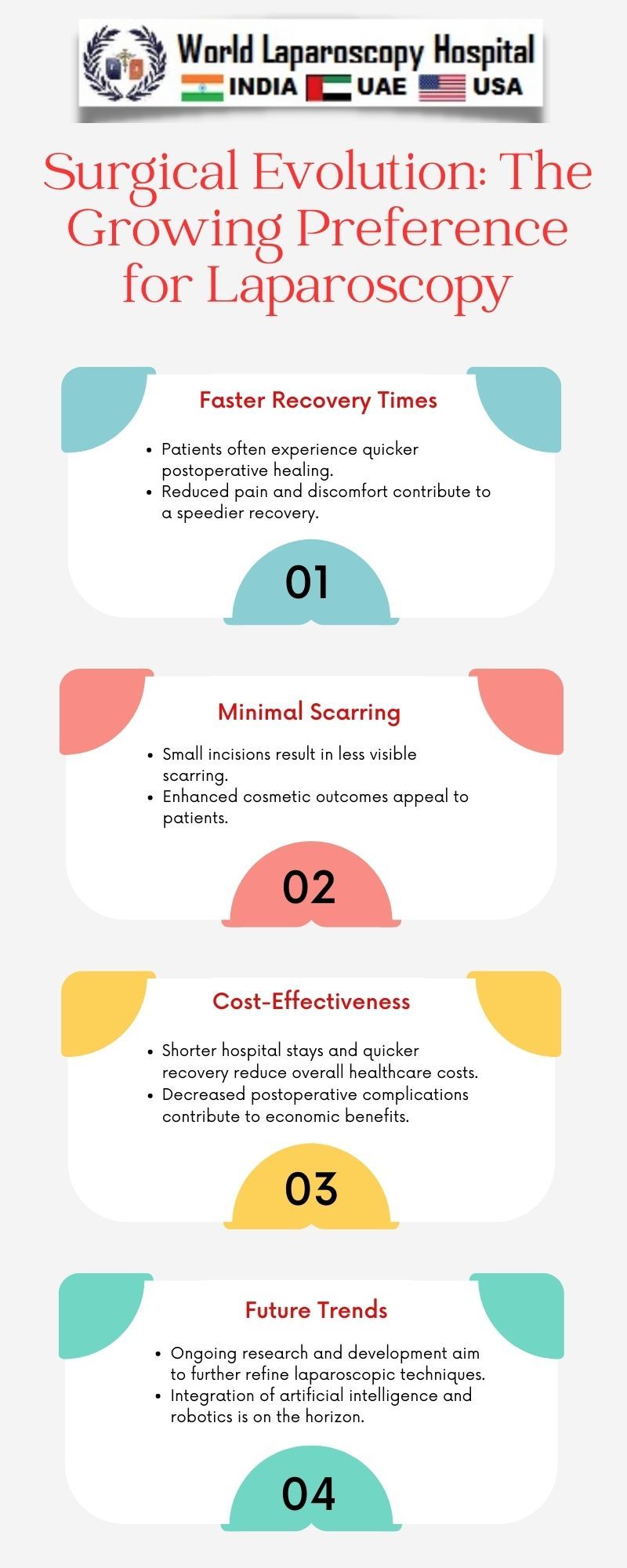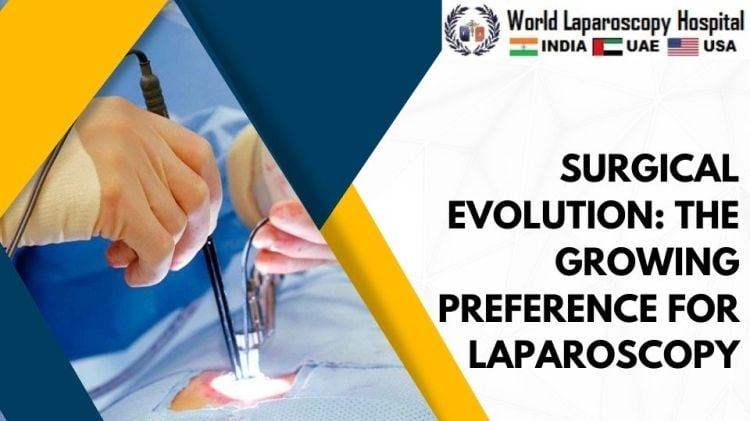Surgical Evolution: The Growing Preference for Laparoscopy
Introduction:
The landscape of surgical procedures is undergoing a remarkable transformation, with the increasing preference for laparoscopy reshaping the way surgeons approach various medical interventions. Laparoscopy, also known as minimally invasive surgery, involves making small incisions through which a camera and specialized instruments are inserted, allowing surgeons to perform complex procedures with greater precision. This article explores the historical context, technological advancements, and the myriad benefits that contribute to the growing popularity of laparoscopy in modern medicine.

Historical Perspective:
Laparoscopy's roots can be traced back to the early 20th century when the first attempts were made to visualize the abdominal cavity using a rudimentary form of endoscope. However, it wasn't until the 1980s that laparoscopy gained widespread acceptance as a surgical technique. The advent of fiber optics and improvements in camera technology paved the way for clearer and more detailed visualization, marking the beginning of a new era in surgery.
Technological Advancements:
The evolution of laparoscopy is intricately linked to technological advancements that have enhanced both the imaging capabilities and surgical instruments used in the procedure. High-definition cameras provide surgeons with crystal-clear images of the operative field, enabling them to navigate with unprecedented accuracy. Additionally, robotic-assisted laparoscopy has emerged as a cutting-edge development, allowing for enhanced dexterity and precision, further expanding the scope of minimally invasive procedures.
Versatility in Surgical Specialties:
One of the key factors contributing to the surge in laparoscopic procedures is its versatility across various surgical specialties. Initially employed primarily in gynecology and general surgery, laparoscopy has found applications in urology, orthopedics, and even certain cardiac procedures. The ability to adapt the technique to different medical fields has broadened its appeal and solidified its status as a preferred surgical approach.
Benefits of Laparoscopy:
Minimized Trauma and Faster Recovery:
The hallmark of laparoscopy lies in its minimally invasive nature, involving small incisions compared to traditional open surgeries. This results in reduced trauma to surrounding tissues, leading to faster recovery times for patients. Shorter hospital stays and quicker return to daily activities contribute to improved patient satisfaction.
Reduced Postoperative Pain:
Smaller incisions not only expedite recovery but also translate to less postoperative pain for patients. The trauma inflicted on nerves and muscles is significantly reduced, contributing to a more comfortable postoperative experience. This aspect has a profound impact on patient outcomes and contributes to the overall appeal of laparoscopy.
Enhanced Cosmetic Outcomes:
The cosmetic aspect of surgery is often overlooked but can have a considerable impact on a patient's well-being. Laparoscopy's reliance on small incisions leads to less scarring, promoting improved cosmetic outcomes. This aesthetic advantage adds another layer to the appeal of laparoscopy, particularly in elective procedures where appearance matters to patients.
Lower Risk of Infections:
The reduced size of incisions not only minimizes trauma but also lowers the risk of postoperative infections. In traditional open surgeries, larger wounds are more susceptible to infections, which can significantly impact recovery. Laparoscopy's smaller incisions contribute to a lower likelihood of infection, further enhancing its safety profile.
Quicker Return to Normal Function:
Laparoscopic procedures often allow patients to resume normal activities more quickly than their open surgery counterparts. This aspect is particularly crucial in cases where the patient's lifestyle and daily responsibilities are significant factors in the decision-making process. The ability to return to work and daily routines sooner is a compelling factor for both patients and healthcare providers.
Challenges and Considerations:
Learning Curve for Surgeons:
While laparoscopy offers numerous advantages, it is not without its challenges. Surgeons need to undergo specialized training to master the technique, as laparoscopic procedures require a different skill set compared to traditional open surgeries. The learning curve can be steep, but the long-term benefits justify the investment in training.
Cost Implications:
The initial costs associated with laparoscopic equipment and technology can be higher than those of traditional open surgery. However, the potential for reduced hospital stays and quicker recovery may offset these initial expenses in the long run. Cost-effectiveness is an ongoing consideration in the wider adoption of laparoscopy.
Patient Selection Criteria:
While laparoscopy is suitable for a wide range of procedures, not all patients are ideal candidates. Certain medical conditions, anatomical factors, or the complexity of the surgery may necessitate a traditional open approach. Careful patient selection is crucial to ensuring optimal outcomes and avoiding complications.
Limited Tactile Feedback:
One of the inherent limitations of laparoscopy is the lack of tactile feedback for surgeons. Unlike open surgery, where the surgeon can feel tissues and structures with their hands, laparoscopy relies on visual and hand-eye coordination. Advances in haptic technology are addressing this limitation, providing tactile feedback to surgeons during laparoscopic procedures.
Future Directions:
Integration of Artificial Intelligence:
The integration of artificial intelligence (AI) in laparoscopic surgery holds great promise. AI algorithms can assist surgeons in image interpretation, decision-making, and even performing certain tasks autonomously. This collaborative approach between surgeons and AI has the potential to further enhance the precision and efficiency of laparoscopic procedures.
Continued Innovation in Robotics:
Robotic-assisted laparoscopy, with systems like the da Vinci Surgical System, continues to evolve. Ongoing research aims to improve robotic interfaces, enhance surgeon control, and expand the range of procedures that can benefit from robotic assistance. As these systems become more sophisticated, they are likely to play an increasingly prominent role in minimally invasive surgery.
Wider Adoption in Developing Countries:
The benefits of laparoscopy, including reduced hospital stays and quicker recovery, make it particularly appealing in resource-limited settings. Efforts to make laparoscopic technology more accessible and affordable are underway, with the goal of expanding its use in developing countries where the burden of surgical diseases is significant.
Conclusion:
The growing preference for laparoscopy in modern medicine is a testament to the transformative impact of technological innovation on surgical practices. From its humble beginnings in the early 20th century to the present day, laparoscopy has evolved into a versatile and widely adopted surgical technique. The myriad benefits, including minimized trauma, faster recovery, and enhanced cosmetic outcomes, position laparoscopy as a cornerstone in the evolution of surgical methods.
As technology continues to advance, and as surgeons gain proficiency in laparoscopic techniques, the scope of minimally invasive surgery is likely to expand further. With ongoing developments in robotics, artificial intelligence, and increased accessibility in developing countries, laparoscopy is poised to play an increasingly pivotal role in shaping the future of surgical innovation.
